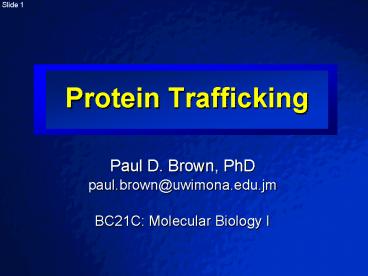Protein Trafficking - PowerPoint PPT Presentation
1 / 29
Title:
Protein Trafficking
Description:
OM, outer membrane; TL, thylakoid lumen; TM, thylakoid membrane ... New proteins in ER lumen or membrane incorporated into vesicles, which fuse with ... – PowerPoint PPT presentation
Number of Views:4008
Avg rating:3.0/5.0
Title: Protein Trafficking
1
Protein Trafficking
- Paul D. Brown, PhD
- paul.brown_at_uwimona.edu.jm
- BC21C Molecular Biology I
2
Learning Objectives
- Describe the various ways in which proteins can
be sorted/translocated - Co-translational translocation
- Post-translational translocation
- Know the different mechanisms by which proteins
leave the cytosol and enter the - nucleus
- mitochondria
- ER
- Golgi network
- The role of signal sequences in this process
- The fate of protein whose sorting signal was
mutated - The secretory pathway
3
Overview of sorting of nuclear-encoded proteins
4
Protein translocation systems
- IM, inner membrane IMS, inner membrane space P,
periplasm - OM, outer membrane TL, thylakoid lumen TM,
thylakoid membrane - SecYEG, Sec61, TOM, TIM, TOC are protein subunits
of the translocation systems - Adapted from Schatz and Dobberstein, Science 271,
1519 (1996)
5
Protein pathways
- Proteins released into cytosol
- Processed to contain specific uptake-targeting
sequences (later removed by proteases) - Imported into mitochondrion, chloroplast,
peroxisome, nucleus - Mitochondria and chloroplasts contain organelle
DNA, which encodes organelle rRNAs and tRNA, but
few organelle proteins - Most mitochondrial and chloroplast proteins are
encoded by nuclear genes, which are translated by
cytosolic ribosomes and then imported - May be sorted to other organellar compartments
(second signal sequence)
6
Specific uptake-targeting sequences
7
Uptake-targeting sequences of imported
mitochondrial proteins
8
A cell-free system for studying
post-translational uptake of mitochondrial
proteins
9
Translocation into mitochondria
- Cytosolic chaperones deliver proteins to
channel-linked receptors in the mitochondrial
membrane - Delivery of preproteins depend on Hsp70/Hsp40 or
MSF - Uptake of mitochondrial proteins requires energy
ATP in the cytosol, the proton-motive force
across the inner membrane, and ATP in the matrix
10
Translocation into chloroplasts
- Toc components mediate translocation (Toc75 is
the translocon) Hsp70/ Hsp40 may be involved - Hsp70 in both the IMS and the stroma assist the
threading of the preprotein into the chloroplast - An Hsp100 chaperone also called ClpC (AAA ATPase)
also binds preproteins in the stroma - Hsp70/chaperonin (Cpn60) may assist
folding/assembly of newly-imported protein - Import into thylakoids (used for respiration)
uses the SRP pathway
11
Translocation into peroxisomes
- Targeting of proteins is initiated
post-translationally by Pex5/7 proteins, which
bind the peroxisomal targeting signal (PTS), SKL - Translocon is Pex14p receptor
- Gated pore that is regulated by membrane
proteins? - First organelle demonstrated to import proteins
without a PTS, by virtue of assembly with other
proteins that contained a PTS - Various protein oligomers are imported into
peroxisomes - Peroxisomal protein import is defective in some
genetic diseases, e.g., Zellweger syndrome
12
Protein pathways
- Secretory pathway
- Ribosome/mRNA/protein complexes are directed to
rough endoplasmic reticulum by ER signal sequence - After translation, proteins move via transport
vesicles to Golgi apparatus - Packaged (disulfide bonds, addition of
carbohydrates, proteolytic cleavages, assembly
into multimeric units) proteins directed to cell
surface (secretion), lysosome, or plasma membrane
13
The rough ER is an extensive interconnected
series of flattened sacs
14
Secretory proteins are found in the ER lumen
immediately after synthesis
15
Overview of the secretory pathway
- Cisternal progression
- New proteins in ER lumen or membrane incorporated
into vesicles, which fuse with cis-Golgi or with
each other - Migration from cis- to trans-Golgi
(localization), and undergo modifications - Some remain, while others move via small vesicles
to cell surface or lysosomes - Secretion may be regulated or constitutive
16
Many experiments on the secretory pathway have
relied on cells specialized for the secretion of
certain proteins
17
Analysis of yeast mutants defined the major steps
in the secretory pathway
18
Translocation into the ER
19
Topologies of some integral membrane proteins
synthesized on the rough ER
20
Most nominal cytosolic transmembrane proteins
have an N-terminal signal sequence and an
internal topogenic sequence
21
Multipass transmembrane proteins have multiple
topogenic sequences
22
After insertion into the ER membrane, some
proteins are transferred to a GPI anchor
23
Post-translational modifications and quality
control in the rough ER
- Newly synthesized polypeptides in the membrane
and lumen of the ER undergo five principal
modifications - Formation of disulfide bonds
- Proper folding
- Addition and processing of carbohydrates
- Specific proteolytic cleavages
- Assembly into multimeric proteins
24
Golgi and post-Golgi protein sorting
- Sequences in the membrane-spanning domain cause
the retention of proteins in the Golgi - Different vesicles are used for constitutive and
regulated protein secretion - Proproteins undergo
- proteolytic processing
- late in maturation
25
Receptor-mediated endocytosis generally occurs
via clathrin-coated pits and vesicles
26
The LDL receptor binds and internalizes
cholesterol-containing particles
27
The endocytic pathway delivers transferrin-bound
iron to cells
Transcytosis moves some ligands across cells
28
At least three types of coated vesicles transport
proteins from organelle to organelle
29
Translocation in bacteria
- Two major pathways for translocation in bacteria
Sec and SRP pathways - Both converge at SecYEG translocon and use SecA,
a peripherally-bound ATPase that supplies the
energy for translocation - SecB binds to nascent chains containing a signal
sequence and maintains the preprotein in
translocation-competent form, then binds SecA
SRP docks with membrane receptor, FtsY (simpler
homologues of eukaryotic SRP and SRP receptor)
- Archaea lack SecB, have SRP/FtsY but no SecA
what drives translocation? - Archaeal SRP, FtsY, SecYEG more closely related
to eukaryotic proteins (SecYEG)































